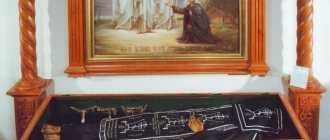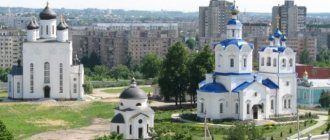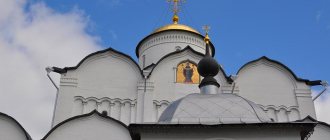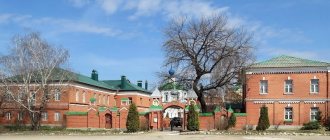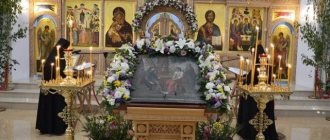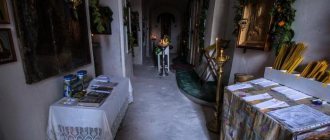Mir
Russia Perm region Perm Holy Trinity Stefanov Monastery Map loading in progress...
{"format":"leaflet","minzoom":false,"maxzoom":false,"limit":50,"offset":0,"link":"all","sort":[""], "order":[],"headers":"show","mainlabel":"","intro":"","outro":"","searchlabel":"\u2026 \u0441\u043b\u0435\ u0434\u0443\u044e\u0449\u0438\u0435 \u0440\u0435\u0437\u0443\u043b\u044c\u0442\u0430\u0442\u044b","default":"","import-annotation":false,"width ":"auto","height":"350px","centre":{"text":"","title":"""link":"""lat":58.0371999999999985675458447076380252838134765625,"lon": 56.32050000000000267164068645797669887542724609375,"icon":""},"title":"","label":"","icon":"","lines":[],"polygons":[],"circles":[ ],"rectangles":[],"copycoords":false,"static":false,"zoom":8,"defzoom":14,"layers":["OpenStreetMap"],"image layers":[] ,"overlays":[],"resizable":false,"fullscreen":true,"scrollwheelzoom":true,"cluster":false,"clustermaxzoom":9,"clusterzoomonclick":true,"clustermaxradius":80, "clusterspiderfy":true,"geojson":"","clicktarget":"","showtitle":true,"hidenamespace":false,"template":"","userparam":"","activeicon": "","pagelabel":false,"ajaxcoordproperty":"","ajaxquery":"","locations":[{"text":"\u003Cb\u003E\u003Ca href=\"/palomnik/%D0% A1%D0%B2%D1%8F%D1%82%D0%BE-%D0%A2%D1%80%D0%BE%D0%B8%D1%86%D0%BA%D0%B8%D0%B9_ %D0%A1%D1%82%D0%B5%D1%84%D0%B0%D0%BD%D0%BE%D0%B2_%D0%BC%D1%83%D0%B6%D1%81%D0 %BA%D0%BE%D0%B9_%D0%BC%D0%BE%D0%BD%D0%B0%D1%81%D1%82%D1%8B%D1%80%D1%8C\" title= \u0421\u0432\u044f\u0442\u043e-\u0422\u0440\u043e\u0438\u0446\u043a\u0438\u0439 \u0421\u0442\u0435\u0444\u0430\u043d\u043 e\u0432\u043c\u0443\ u0436\u0441\u043a\u043e\u0439 \u043c\u043e\u043d\u0430\u0441\u0442\u044b\u0440\u044c\»\u003E\u0421\u0432\u044f\u0442\u043e-\ u0422\u0440\u043e\u0438 \u0446\u043a\u0438\u0439 \u0421\u0442\u0435\u0444\u0430\u043d\u043e\u0432 \u043c\u0443\u0436\u0441\u043a\u043e\u0439 \u043c \u043e\u043d\u0430\u0441\u0442 \u044b\u0440\u044c\u003C/a\u003E\u003C/b\u003E\u003Chr /\u003E\u003Ca href=\»/palomnik/%D0%A1%D0%B2%D0%BE%D0%B9%D1 %81%D1%82%D0%B2%D0%BE:%D0%90%D0%BD%D0%BD%D0%BE%D1%82%D0%B0%D1%86%D0%B8%D1% 8F\" title=\"\u0421\u0432\u043e\u0439\u0441\u0442\u0432\u043e:\u0410\u043d\u043d\u043e\u0442\u0430\u0446\u0438\u044f\"\u003E\u04 10\u043d \u043d\u043e\u0442\u0430\u0446\u0438\u044f\u003C/a\u003E: "'\u0421\u0432\u044f\u0442\u043e-\u0422\u0440\u043e\u0438\u0446\u 043a\u0438\u0439 \u0421\u0442\u0435\u0444\u0430\u043d\u043e\u0432 \u043c\u043e\u043d\u0430\u0441\u0442\u044b\u0440\u044c"' \u2014 \u043c\u04 43\u0436\u0441\u043a\u043e \u0439 \u043c\u043e\u043d\u0430\u0441\u0442\u044b\u0440\u044c \u041f\u0435\u0440\u043c\u0441\u043a\u043e\u0439 \u0435\u043f \u0430\u0440\u0445\u0438\u0438 \u0420\u0443\u0441\u0441\u043a\u043e\u0439 \u043f\u0440\u0430\u0432\u043e\u0441\u043b\u0430\u0432\u043d\u043e\u0439 \u0446\ u0435\u0440\u043a\u0432\u0438 . """title":"\u0421\u0432\u044f \u0442\u043e -\u0422\u0440\u043e\u0438\u0446\u043a\u0438\u0439 \u0421\u0442\u0435\u0444\u0430\u043d\u043e\u0432 \u043c\u0443\u0436\u0441\ u043a\u043e\u0439\u043c\ u043e\u043d\u0430\u0441\u0442\u044b\u0440\u044c","link":"","lat":58.0371999999999985675458447076380252838134765625,"lon":56.320500000 00000267164068645797669887542724609375,"icon":""}],"imageLayers":[ ]}
58.037103; 56.320416
Russia, Perm, Visimskaya street, 4A
Perm, Perm region 614014
Russia
Telephone:
+7 (342) 267 52 22, 267 51 00 (it is advisable to call on weekdays from 9:00 to 17:00)
Email:
Holy Trinity Stephen Monastery
- a male monastery of the Perm diocese of the Russian Orthodox Church. Located in Perm.
History[edit]
In 1790, the Motovilikha State Plant was separated from the parish of the Peter and Paul Cathedral and, according to a charter given by His Eminence Lawrence, Bishop of Vyatka and Veliko-Perm, dated December 18, 1789, No. 2025, with the bishop’s seal, the construction of a wooden church began in the very center of Motovilikha in the name of the Most Holy Life-Giving Trinity. The new church was consecrated on December 20 (31), 1790. The first priest of the Holy Trinity Church was deacon Philip Sapozhnikov, identified from the Peter and Paul Cathedral.
In 1816, according to a charter given by His Grace Justin, Bishop of Perm and Yekaterinburg, dated December 22, 1816, with the bishop’s seal, instead of the dilapidated wooden church in Motovilikha, the construction of a stone church in the name of the Life-Giving Trinity began. The plan and facade of the new church was drawn up and signed by the provincial architect Pyotr Timofeev Vasiliev (d. April 13, 1835) on May 11, 1817; on this plan there was the blessing of His Grace Justin, Bishop of Perm and Yekaterinburg.
The stone church was built in 1828, construction was carried out mainly with funds donated by artisans from their earnings. The builder of the church was a retired artisan, Ivan Ilyin Vasiliev (died November 18, 1835), elected by the parishioners. The bell tower, designed by the provincial architect Vasiliev (the lower tier in the classical style), was erected by master Nikanor Belonogov.
On March 15 (27), 1836, the consecration of the church in the name of the Holy Life-Giving Trinity took place.
The appearance of the Holy Trinity Church was unusual in comparison with other churches in Perm at the beginning of the 19th century. Decorated with kokoshniks and carvings, the quadrangle with five domes was reminiscent of Moscow and Solikamsk churches of the 16th-17th centuries and combined elements of Old Russian and classical styles. Later, side aisles were built. The southern one (right) was dedicated to the feast of the Presentation of the Lord. The northern warm chapel was consecrated on May 26, 1863 in honor of the Dormition of the Mother of God.
In 1824, a new cemetery was established at the Motovilikha plant by decree. Since 1826, burials began to take place at the Holy Trinity Church, the altar part of which became the resting place of the Motovilikha clergy, primarily local clergy and members of their families. In addition to the graves of the clergy, a number of other burials were presented in the church cemetery - philanthropists and public figures of Motovilikha of that time, incl. famous inventor Nikolai Gavrilovich Slavyanov. The church cemetery was liquidated (razed to the ground) after the reburial of the remains of Slavyanov N.G. in 1948.
In 1901, under the supervision of architect A.I. Ozhegov, the reconstruction of the Holy Trinity Church was carried out, in particular, the upper tier of the bell tower was built (in the Old Russian style).
On October 14, 1928, His Eminence Bishop of Perm Hieromartyr Pavlin (Kroshechkin) and his vicar Bishop of Solikamsk Khrisanf (Klementyev) Motovilikha Holy Trinity Church was elevated to the rank of a Cathedral in the year of its 100th anniversary.
The most outstanding priests and rectors of the Holy Trinity Church in its entire history were: Priest Evfimy Andreev Konyukhov, the founder of the priestly dynasty, who served from 1827 to 1857; Archpriest Vasily Stepanov Zemlyanitsyn, former rector of the Peter and Paul Cathedral; Archpriest Alexander Yakovlevich Popov, who was rector for 34 years, from 1864 to 1900; Archpriest Ioann Alekseevich Nikitin; priest Vasily Georgievich Morozov; Archpriest Pavel Vasilyevich Konyukhov (grandson of Evfimy Konyukhov), the last rector of the Holy Trinity Cathedral of Motovilikha.
During the Soviet era of persecution of the church and faith, on May 15, 1936, the Holy Trinity Cathedral was closed. The last rector of the temple and all the priests were arrested and died in the camps. For many decades, the church building was occupied by bakery No. 3.
Company for the closure of churches in the late 20s - early 30s. took place according to a clearly developed scenario. The reporting and inspection commission of the City Council relied on the initiative of the working class, which protested against the “opium of the people.” From the decision of the City Executive Committee of 1947 and a certificate we learn that the Holy Trinity Church was closed in 1936, and the building was completely, “overhauled” converted into a bakery.
The active resistance of parishioners influenced the delay in the closure of the temple. Divine services there continued until 1935, when the rector, Fr. Pavel (Konyukhov). Formally, the reason for the arrest was a denunciation that said that the priest remembered the murdered Emperor Nicholas and his wife during the liturgy. Simultaneously with Fr. Paul took three priests and two laymen to prison.
All of them were subsequently shot. Now, having deprived the temple of clergy, it was decided to close it completely. The years 1938-1939 became a tragedy for the believers of Motovilikha. when the church was almost completely destroyed. All that remains of its former splendor is the one-story base of the temple, in the altar of which a unit for kneading dough was installed.
It took more than half a century for prosphora to be brought from the church instead of bagels. A lot of effort was spent until finally, by Decree of the Perm city administration No. 2039 of November 15, 1994, the Parish Council of the Holy Trinity Church “for the existing complex” was granted 0.612 hectares of land for indefinite use. The same one that previously belonged to the temple. The church building, or rather, what was left of it, was a ruin: bricks were falling out of the dilapidated walls, in some places the surviving plaster hung in dirty shreds, broken windows gaped with black emptiness or were boarded up. For many, restoring the temple’s former appearance seemed impossible...
On December 3, 1994, on the eve of the Feast of the Entry of the Most Holy Theotokos into the Temple, a new page opens in the long-suffering history of the Holy Trinity Church. A temporary iconostasis has been erected in the whitewashed Assumption chapel, cleared of debris, and services begin. The hours of worship are still written in chalk on the iron fence, but the temple is filled with people more and more every day.
On February 3, 1995, the Holy Trinity Stephen Monastery was officially registered, and on February 2, 1996, the monastery’s charter was adopted. The viceroy from 1995 to 2004 was Archimandrite Stefan (Seksyaev), since 2004 Hegumen Bartholomew (Sibiryakov).
Along with the reconstruction of the Holy Trinity Church, monastic hermitages are being created on the basis of churches that are opening or under construction. In them, if possible, worship begins almost immediately, parallel to the restoration.
In 1995, a new temple of the Mother of God “Quick to Hear” was built in the village of Verkhnyaya Kurya.
At the Northern Cemetery, a place is being consecrated for the temple-chapel “All Saints Who Shine in the Land of Russia”
In 1996, monasteries were formed in the village of Vorobyi - Krestovozdvizhensky and in the village. Krasnaya Sludka - Voznesensky, and in the center of Perm a courtyard is being organized in the newly returned chapel of St. Stephen of Great Perm.
In 1997, in the military unit of the village of Zvezdny, a temple was consecrated, which the monastery was entrusted with caring for.
A monastery opens in the village of Uspenka, where the Rev. Trifon Vyatsky.
In 1999, two more monasteries were added - in the village of Visim a small church was built in honor of the Icon of the Mother of God “Tenderness”, and in the north, in the village. The Church of the Nativity of Christ is being restored.
On December 4, 1999, the central dome of the monastery church shone, and a cross was erected above it. The main bell of the belfry weighing 1300 kg was also installed - the largest in Perm. Even earlier, on May 9, 1999, for the patronal feast day, the lower church of St. Stephen of Great Perm was built.
On April 26, 2000, on Holy Wednesday, the bell tower acquired its finished form - it was crowned with a tent. The Holy Trinity Cathedral appeared as it was before 1938. On February 14, 2001, on the eve of the patronal feast, the restored Sretensky chapel was consecrated. The main church, Trinity, is open on Easter. By the end of the year, work on recreating the Assumption Chapel was completed.
With the assistance of the city and district administration, landscaping of the area adjacent to the church was carried out. The construction of the monastery wall, in which utility rooms are provided, has begun, and a fraternal building has been laid.
Currently, the Holy Trinity Church of the monastery has been completely restored. The area next to the monastery is landscaped. The author of the project for the restoration of the Holy Trinity Church is A.A. Metelev, together with priest Valery Zhekhov, developed a master plan for the architectural development of the monastery. The monastery development program is designed for 25 years and involves the creation of a complex that includes cells, a library, workshops, a Sunday school and other necessary premises.
From April 2004 to 2011, the abbot of the monastery was Abbot Bartholomew (Sibiryakov).
On August 24, 2011, Abbot Seraphim (Danilenko) was appointed acting. Abbot of the Holy Trinity Stephen Monastery. By the decision of the Holy Synod of July 15, 2021, Abbot Seraphim was confirmed in the position of abbot of the monastery (journal No. 73.1).
On July 20, 2012, the Charter of the Religious Organization of the Perm Holy Trinity Stephen Monastery was approved with changes and additions in a new edition with a new name: Religious organization “Perm Holy Trinity Stephen Monastery of the Perm Diocese of the Russian Orthodox Church (Moscow Patriarchate).”
Assumption Convent (Perm)[edit]
Construction of the monastery began in 1875 at the expense of the merchant brothers Grigory and Fyodor Kamensky. By this time, a women's community had formed on the outskirts of the city of Perm. Already in 1882, by decision of the Holy Synod, the community received the status of a monastery. The main cathedral of the monastery, the Assumption Cathedral of the Blessed Virgin Mary, was decorated with the iconostasis of the great artist M. V. Nesterov. On May 1, 1905, construction began on a stone church in honor of the Icon of the Mother of God of Kazan. The temple was consecrated on October 12, 1908. Artists S. I. Vashkov (wooden carved iconostasis and sketches of utensils) and N. K. Roerich took part in the design of the iconostasis and interior decoration of the church.
In 1918, the property of the Assumption Monastery was municipalized. And already in 1920 the Assumption Perm Monastery was closed. In 1933, the monastery buildings fell into the area where a military unit was located. In 1985, the revival of restoration work by Perm special scientific and restoration workshops began.
Address
: 614068, Russia, Perm region, Perm, Plekhanova street, 39/5
Phones
: +7 (342) 236-87-96, (342) 236-77-50
Current state[edit]
Perm Holy Trinity Stephen Monastery is one of the main operating monasteries of the Perm diocese of the Russian Orthodox Church of the Moscow Patriarchate. Established with the blessing of the Holy Synod of the Russian Orthodox Church on May 5, 1995 at the Church of the Holy Life-Giving Trinity in Motovilikha.
The temple has four altars: the main altar in honor of the Holy Trinity, the right aisle in honor of the Presentation of the Lord, the left aisle in honor of the Dormition of the Mother of God and the lower cave church in honor of St. Stephen of Great Perm. In the Holy Trinity Church of the monastery there are two relics with particles of the relics of St. Fathers of Kiev-Pechersk and Optina and other saints. There is also a revered copy of the image of the Mother of God “The Inexhaustible Chalice”, before which a water-blessing prayer service with an akathist is served every Saturday.
Also at the monastery there are several monasteries, farmsteads and attached chapels
, among which:
- Holy Cross Monastery (village of Govyrino, Nytvensky district);
- house chapel of the Holy Prophet John the Baptist (Balatovo microdistrict);
- hospital church-chapel in honor of the icon of the Mother of God “Vsetsaritsa” at the children's regional oncology clinic;
- hospital church-chapel of St. Luke of Crimea at the Heart Institute;
- chapel in honor of St. blgv. Prince Mikhail Tverskoy (m/r Chapaevsky).
In the Holy Trinity Stephen Monastery and its monasteries, about 70 people asceticize, more than 20 of whom took monastic vows. The inhabitants of the monastery, in addition to prayer and obedience, are engaged in cultural and social work: they teach at the Perm Theological Seminary and at the Department of Theology of PSU, speak at scientific conferences, engage in the rehabilitation of drug addicts, and provide care for military personnel.
The monastery operates:
- catechetical conversations for adults (before baptism - a mandatory cycle with an interview at the end);
- Sunday school for children;
- Sunday school of preschool education in honor of the svmch. Tsarevich Alexy;
- art studio for preschool children;
- Orthodox library in honor of Saints Cyril and Methodius;
- Orthodox video lecture;
- icon painting workshop “Dobro”;
- workshop for sewing church vestments;
- Museum-school named after Empress Alexandra Feodorovna;
- Orthodox children's summer camp "Svecha" in the village. Krasnaya Sludka, Dobryansky district;
- public organization “Orthodox Youth of the Kama Region”;
- Orthodox community for the deaf and dumb in honor of the holy martyrs Vera, Nadezhda, Lyubov and their mother Sophia.
Students of the icon painting department of the Perm Theological Seminary also study at the monastery.
Every year the already traditional procession of the cross from the monastery to the chapel of St. blgv. book Mikhail Tverskoy (at the site of the alleged murder of Grand Duke Mikhail Romanov), concerts of spiritual chants, socially significant events.
Content
- 1 Holy Trinity Stephen Monastery
- 2 Assumption Convent (Perm)
- 3 Bakharevsky Mother of God-Kazan Seraphim-Alekseevsky Convent
- 4 Belogorsky Nikolaevsky Monastery
- 5 St. John the Theologian Monastery (Cherdyn)
- 6 Nikolsky Convent (Nikolaevskoe)
- 7 Obvinsky Holy Dormition Convent
- 8 Lazarevsky Convent (Vereshchagino)
- 9 Epiphany Monastery (Perm)
- 10 Verkhne-Chusovskaya Kazan Trifonova women's hermitage
- 11 John the Baptist Convent (Kungur)
- 12 Holy Trinity Solikamsk Monastery
- 13 Solikamsk Krasnoselsky St. John the Baptist Convent
- 14 Usolsky Spaso-Preobrazhensky Convent
- 15 Skete of St. Tryphon of Vyatka (Pyskor)
Shrines[edit]
An icon of the Savior not made by hands from the beginning of the 19th century.
In the Perm Holy Trinity Stephen Monastery, in the central chapel of the temple there is an icon of the Savior Not Made by Hands from the beginning of the 19th century. And also the icon of the Most Holy Theotokos the Tsaritsa (Pantanassa), painted at the request of the parishioners of the temple in the icon-painting workshop at the monastery for the 5th anniversary of the monastery. Before the revolution, the icon of the Most Holy Theotokos of Kazan was in the Church of the Holy Trinity; it was saved from desecration by a pious parishioner and was kept in her home for a long time. Repeatedly she wanted to take the icon to the Belogorsk Monastery, but to no avail. Before the beginning of the new millennium, she saw a dream in which the Mother of God ordered the icon to be returned to her in the Church of the Holy Life-Giving Trinity, where it was located before the revolution. The icon of the holy healer Panteleimon has a piece of his relics.
The help is evidenced by the gifts of parishioners located in the icon case.
On the occasion of the 5th anniversary of the founding of the monastery, a copy of the icon of the Most Holy Theotokos “The Inexhaustible Chalice” was also written; the first akathist to the Most Holy Theotokos was read and a prayer service was served with the blessing of water before her icon on January 5, 2000. From that time on, on Saturdays after the liturgy (except for church holidays and Mother's Saturdays), the monastery began to constantly read the akathist and serve the Holy Blessing prayer before this revered image.
Many are cured, as evidenced by the replenished gifts to the Lady for Her great mercy, which are in the icon case.
List of particles of relics from the reliquaries of the Holy Trinity Cathedral of the monastery
Photos
The complex of cathedral buildings looks not only beautiful, but also very impressive. Restored, they attract the eye with their fresh, delicate color and graceful architectural form:
The bell tower of the temple, towering above the complex, is the tallest in the city. It stretches into the sky, its bells carry their ringing over vast distances. And the gates of the cathedral are decorated with images of biblical scenes, creating the necessary atmosphere already on the approach to the cathedral building itself:
The temple has not changed much over time. Photo reports of travelers of the 19th century, who repeatedly recorded its appearance and told their friends about the beauty they saw, can tell us about this. And even though in those days it was impossible to take high-quality photographs, their black and white photos will still remind you that the greatness of the temple has remained unchanged:
The cathedral (unlike many similar structures) avoided many misfortunes. No one took it apart, but simply closed it for a short time. Most likely, this was the result of the attitude of local people towards the stronghold of Orthodoxy.
Verkhne-Chusovskaya Kazan Trifonova women's hermitage[edit]
The history of the monastery began with an almshouse for the elderly at the Church of All Saints. The church-chapel was built in 1849-56. at the expense of the Verkhne-Gorodkovsky merchant Pavel Kropachev and first served as a cemetery assigned church at the Church of the Nativity of the village of Verkhne-Chusovskie Gorodki. In the 20s of the twentieth century, the church was closed, and the building was used as a match factory. At the request of the community, it was returned in 1946, after the closure of the Church of the Nativity. From 1955 to 1981, the rector of the All Saints Church was the elder Archpriest Nikolai Rogozin.
By the providence of God, in 1989, an almshouse was opened at the church, where about ten old women lived, many of whom were the spiritual children of Father Nicholas. By decree of Archbishop Athanasius of Perm and Solikamsk dated September 18, 1992, the almshouse was officially approved.
Address:
Russia, Perm region, Chusovsky district, Krasnaya Gorka village
Telephone:
+7 (919) 7110016 (office); +7 (919) 4752530 (abbess nun Ksenia (Oshchepkova))
John the Baptist Convent (Kungur)[edit]
John the Baptist Convent arose as a female monastic community at the Baptist Church of the city in 1825, officially received the status of a community in 1851, and was transformed into a monastery in 1868.
Closed in 1921, the territory has been occupied by a prison since 1926.
Since July 1, 2015, active work has been underway to restore the sister buildings and restore the churches.
Address:
617470 Perm region, Kungur, Gogol st., 5
Address of the monastery courtyard in the village. Kolpashniks
: 617451 Perm region, Kungur district, village. Kolpashniki, st. Selskaya, 2
Phones:
+7 (34271) 2-15-23; (father Valery Bunakov); +7-952-641-39-75 (telephone number of nun Anisya); +7-950-452-99-06 (phone number of Abbess Rufina)
Email:
St. John the Theologian Monastery (Cherdyn)[edit]
The Cherdyn St. John the Theological Monastery was founded presumably in 1462 by St. Jonah, Bishop of Perm on the picturesque bank of the Kolva River. In 1718, a new stone 2-altar church was built in the Cherdynsky Monastery in honor of the Holy Apostle John the Theologian. But soon, in connection with Catherine’s reform of the Church, all lands were taken away from the monastery. In 1784 the monastery was closed, the monastic estates were transferred to the Trinity-Sergius Lavra. The monastery buildings were sold, the Church of St. John the Theologian was closed. In 1910, at the request of Bishop Palladius of Perm, the monastery was reopened as a women's monastery. After the October Revolution, the monastery was closed in 1919, and the nuns, led by Abbess Rufina Kokoreva, were dispersed.
At the time of its abolition it belonged to the Vyatka diocese of the Russian Orthodox Church. Revived in 2004 as a monastery of the Perm diocese.
On September 13, 2003, the Cherdyn St. John the Theological Monastery celebrated its 540th anniversary. The first Liturgy in many centuries was celebrated by Bishop Irinarch of Perm and Solikamsk. In 2004, by decree of the Holy Synod of the Russian Orthodox Church, the Cherdynsky Monastery was restored as a monastery.
Address:
Perm region, Cherdyn, st. Mamin-Sibiryaka, 17
Usolsky Spaso-Preobrazhensky Convent[edit]
The Spaso-Preobrazhensky Convent is located on the territory of a unique historical and architectural ensemble located in the city of Usolye.
The history of the city is closely connected with the history of the home of the largest landowners, entrepreneurs and salt magnates of Russia, and later the famous philanthropists, the Stroganovs. The monastery arose on the initiative of the head of the Administration of the city of Usolye G.P. Shekhmatov with the blessing of the Archbishop of Perm and Solikamsk Athanasius in 2000. The monastery was located in the Salt Factory Office House. The nuns of the monastery set about restoring the dilapidated St. Nicholas Church. Having been blessed, we served a prayer service to St. Nicholas in a church without windows or doors and began to work. By the grace of God, Easter of Christ 2001, to the great joy of the nuns of the monastery and residents of the surrounding area, was celebrated in the St. Nicholas Church.
Address:
Russia, Perm region, Usolye, st. Republican, 12
Holy Trinity Solikamsk Monastery[edit]
Solikamsk Holy Trinity Monastery under the name of Ascension appeared around 1589-1591. It was founded by townspeople and district peasants. Vasily Anofriev and Prokopiy Moiseev can be considered the first founders. Since 1619, an abbess has been established in the Ascension Monastery. In 1698-1704. The wooden Vozdvizhenskaya Church was replaced with a stone one. In 1731-1734. a gate temple was built in the name of Pri. Mikhail Malein with a bell tower and the upper chapel of St. App. Peter and Paul.
In 1764, the monastery was transferred from the state as a small estate. In 1775, the Pyskorsky Transfiguration Monastery was transferred to it, which in 1793 was transferred to Perm. In 1795, the Trinity Monastery was transferred to Solikamsk from the village. Istobensky, Vyatka province. From that time on, the Ascension Church was renamed Trinity Church with the chapel of the Annunciation of the Blessed Virgin Mary. The gate church was renamed in honor of the icon of the Mother of God “Joy of All Who Sorrow” with an upper chapel in the name of the Ascension of Christ.
Address:
Russia, Perm region, Solikamsk, st. Demyan Bednogo, 25
Telephone:
+7 (34253) 76131; +7 (909) 1128122 (hegumen Innokenty (Denshchikov) abbot of the monastery)
Solikamsk Krasnoselsky St. John the Baptist Convent[edit]
The convent was originally founded as a community at the Krasnoselskaya St. John the Baptist Church.
In 1894 it received the status of a monastery.
In 1921 the monastery was closed and the nuns were evicted.
In 1989, a parish was opened on Krasnoye.
In 2009, by decision of the Holy Synod, the parish was transformed into the Solikamsk Krasnoselsky St. John the Baptist Convent.
Address
: Russia, Perm region, Solikamsk, Privokzalnaya street, 35
Telephone:
+7 (34253) 79800
Bakharevsky Mother of God-Kazan Seraphim-Alekseevsky Convent[edit]
The Bakharevsky Mother of God-Kazan Seraphim-Alekseevsky Convent was officially founded in 1908. Although a female monastic community appeared near the village of Bakharevka back in 1863. After its closure, an almshouse with a shelter for orphans was established on this site.
The Kazan and Intercession churches were founded on the territory of the monastery. During Soviet times, the territory of the shrine was converted into a sanatorium, and the sisters were evicted.
In 1998, the restoration of the house temple and the creation of a monastery began. In 2000, the monastery returned to the status of a monastery. There are holy springs and a bathhouse on the territory.
Address
: 614033, Perm, Bakharevka village, st. Pristantsennaya, 38
Telephone
: +7 (342) 269 52 60
Website
: https://www.bacharevka.narod.ru/index.htm
St. Nicholas Convent (Nikolaevskoye)[edit]
The temple in honor of St. Nicholas the Wonderworker was founded on June 8, 1854 and was built at the expense of Pavel Dmitrievich Diaghilev.
Ten bells were cast especially for the temple; the most important one, the blasphemous one, weighed 192 pounds. The floor of the temple was laid out of natural stone, and oak parquet was laid in the altar. Rich utensils, a sacristy, and books were delivered from St. Petersburg. Architecturally, the St. Nicholas Church is a smaller copy of the Church of the Ascension of Christ in Moscow (architect Nelson-Girt). The Kanavinskaya Church near Nizhny Novgorod was built according to the same project.
Address:
Russia, Perm region, Chernushinsky district, Nikolaevskoye village
Phones:
(34261) 32187;
Epiphany Monastery (Perm)[edit]
The Epiphany Monastery is one of the favorite places for Perm pilgrims who do not like to move away from the city. The monastery is located well in all respects: a beautiful place on the Kama shore, fresh air, green foliage, free of dust, peace and quiet.
The monastery began its existence in 1994, when a good plot of land on the banks of the Kama River, directly opposite the Holy Trinity-Stephen Monastery, was purchased by a wealthy man for the construction of a country house. For some time, the territory for the future cottage was marked out, but it was never built. The businessman who purchased the plot was a believer. Having already acquired the land, he learned that Baptists, Hare Krishnas, and Hindus gather for weekly meetings in the area, but there is not a single Orthodox temple nearby. The proximity to sectarians did not suit this man in any way and, after thinking, he decided to organize a parish of the Russian Orthodox Church on the acquired land. So, instead of another rich dacha, a wooden temple began to grow on the Kama bank.
Address:
Russia, Perm region, Perm, Verkhnyaya Kurya village, st. 1st Line, 53
Belogorsky Nikolaevsky Monastery[edit]
In 1891, in memory of the “miraculous deliverance of Tsarevich Nicholas from danger in Japan,” a seven-foot cross, popularly nicknamed the Tsar’s cross (height 10 m 65 cm), was erected on White Mountain.
The laying of the new stone church (Cathedral of the Exaltation of the Cross) took place on June 24, 1902. The construction of the temple lasted 15 years; at the end of construction, the temple could accommodate 8 thousand people. The chief engineer of the project was E.I. Artyomov, the building material was supplied by the monastery brick factory. The temple was completed and opened in 1917, the consecration of the temple lasted from June 7-9, about 30 thousand people attended the consecration ceremony.
During an audience with Emperor Nicholas II on December 8, 1910, Belogorsk Archimandrite Varlaam gave him a book about the history of the monastery and photographs of the monastery. In 1912, the Belogorsky Monastery published the magazine “Voice of Duty” with an Orthodox-patriotic orientation.
For the strictness of the charter, this monastery was once called the Ural Athos.
Address:
Russia, Perm region, Kungur district, Belaya Gora village, Monastyrskaya street, 1
Telephone:
8 (342) 715-75-35
Lazarevsky Convent (Vereshchagino)[edit]
The Lazarevsky Women's Monastery was founded in 1999 at the Alexander Nevsky Church in Vereshchagino.
The rector of the Vereshchagin church, Rev. Boris Kitsko, shelters for girls and boys were created, and an equestrian school operates.
In the late 2000s, the buildings of the former parochial school in the city, which housed the sisters’ cells, a women’s shelter and a museum, were transferred to the monastery.
Divine services are held in the city Alexander Nevsky Church and the Lazarevsky Church of the monastery monastery in Garevka.
Address
: 617120, Perm region, Vereshchagino, st. K. Marx, 28.
Telephone:
(34254) 3-14-70
Obvinsky Holy Dormition Convent[edit]
The Obvinsky Holy Dormition Convent was founded in 1905 at the Assumption Parish Church on the site of a men's monastery founded in 1686 on the occasion of the appearance of the icon of the Dormition of the Mother of God here, abolished in 1764.
Later, in 1937, the monastery was destroyed.
In May 1997, the revival of the Obvinsky Monastery began.
Address:
617210, Russia, Perm region, Karagay district, village. Obvinsk, st. Michurina, 25
Telephone:
8 (34 297) 27-1-67
Email:


